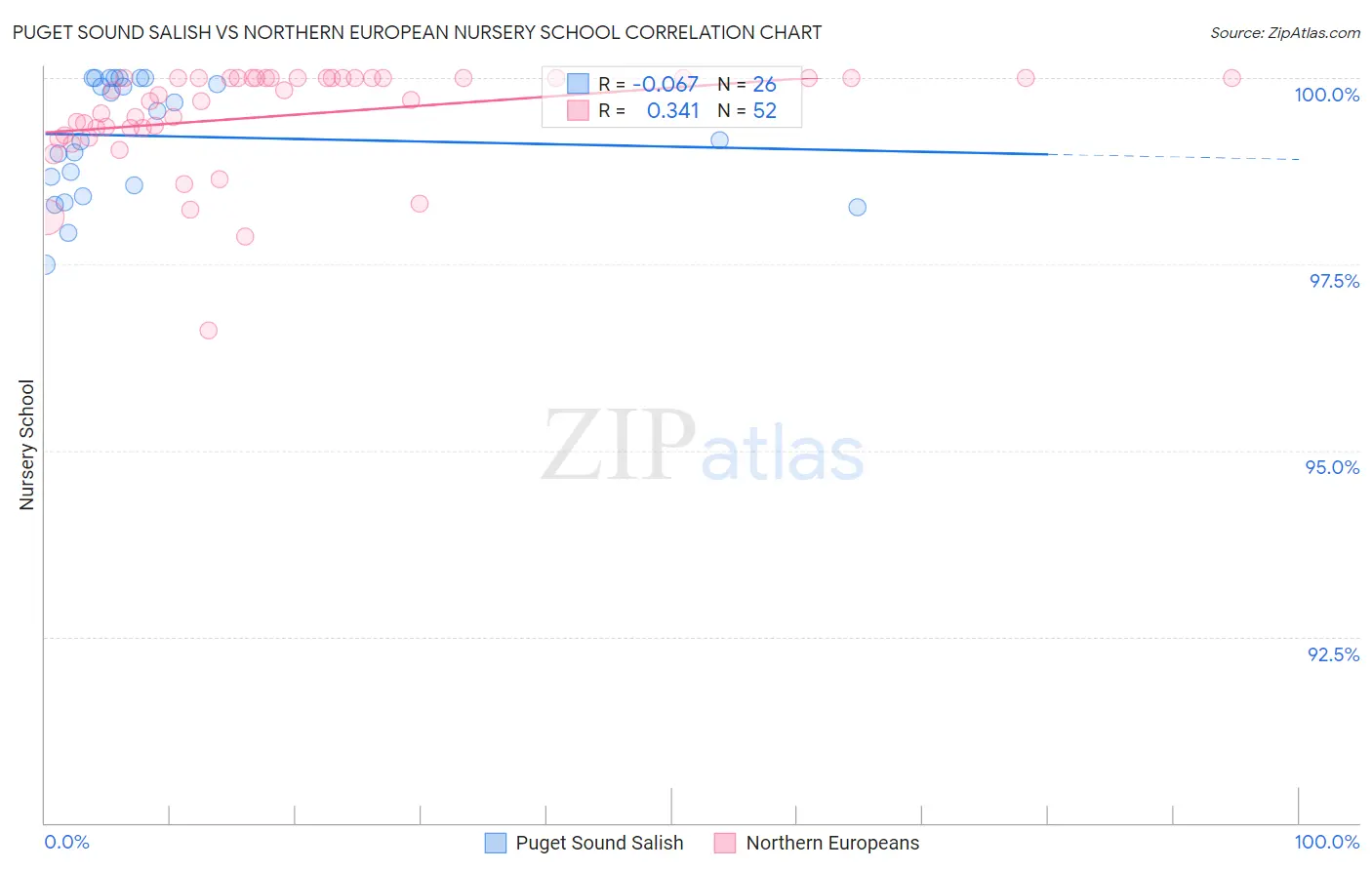Puget Sound Salish vs Northern European Nursery School
COMPARE
Puget Sound Salish
Northern European
Nursery School
Nursery School Comparison
Puget Sound Salish
Northern Europeans
98.3%
NURSERY SCHOOL
98.0/ 100
METRIC RATING
100th/ 347
METRIC RANK
98.5%
NURSERY SCHOOL
99.9/ 100
METRIC RATING
45th/ 347
METRIC RANK
Puget Sound Salish vs Northern European Nursery School Correlation Chart
The statistical analysis conducted on geographies consisting of 46,155,865 people shows a slight negative correlation between the proportion of Puget Sound Salish and percentage of population with at least nursery school education in the United States with a correlation coefficient (R) of -0.067 and weighted average of 98.3%. Similarly, the statistical analysis conducted on geographies consisting of 406,093,361 people shows a mild positive correlation between the proportion of Northern Europeans and percentage of population with at least nursery school education in the United States with a correlation coefficient (R) of 0.341 and weighted average of 98.5%, a difference of 0.23%.

Nursery School Correlation Summary
| Measurement | Puget Sound Salish | Northern European |
| Minimum | 97.5% | 96.6% |
| Maximum | 100.0% | 100.0% |
| Range | 2.5% | 3.4% |
| Mean | 99.2% | 99.5% |
| Median | 99.4% | 99.7% |
| Interquartile 25% (IQ1) | 98.6% | 99.3% |
| Interquartile 75% (IQ3) | 100.0% | 100.0% |
| Interquartile Range (IQR) | 1.4% | 0.72% |
| Standard Deviation (Sample) | 0.78% | 0.70% |
| Standard Deviation (Population) | 0.76% | 0.69% |
Similar Demographics by Nursery School
Demographics Similar to Puget Sound Salish by Nursery School
In terms of nursery school, the demographic groups most similar to Puget Sound Salish are Romanian (98.3%, a difference of 0.0%), Choctaw (98.3%, a difference of 0.010%), Colville (98.3%, a difference of 0.010%), Immigrants from Ireland (98.3%, a difference of 0.010%), and Cree (98.3%, a difference of 0.010%).
| Demographics | Rating | Rank | Nursery School |
| Immigrants | India | 98.7 /100 | #93 | Exceptional 98.3% |
| Immigrants | Germany | 98.6 /100 | #94 | Exceptional 98.3% |
| South Africans | 98.6 /100 | #95 | Exceptional 98.3% |
| Cypriots | 98.3 /100 | #96 | Exceptional 98.3% |
| Immigrants | Nonimmigrants | 98.3 /100 | #97 | Exceptional 98.3% |
| Choctaw | 98.3 /100 | #98 | Exceptional 98.3% |
| Colville | 98.2 /100 | #99 | Exceptional 98.3% |
| Puget Sound Salish | 98.0 /100 | #100 | Exceptional 98.3% |
| Romanians | 97.9 /100 | #101 | Exceptional 98.3% |
| Immigrants | Ireland | 97.7 /100 | #102 | Exceptional 98.3% |
| Cree | 97.7 /100 | #103 | Exceptional 98.3% |
| Bhutanese | 97.4 /100 | #104 | Exceptional 98.2% |
| Turks | 97.4 /100 | #105 | Exceptional 98.2% |
| Immigrants | Switzerland | 97.3 /100 | #106 | Exceptional 98.2% |
| Basques | 97.3 /100 | #107 | Exceptional 98.2% |
Demographics Similar to Northern Europeans by Nursery School
In terms of nursery school, the demographic groups most similar to Northern Europeans are Belgian (98.5%, a difference of 0.0%), Luxembourger (98.5%, a difference of 0.010%), Eastern European (98.5%, a difference of 0.010%), Native Hawaiian (98.5%, a difference of 0.010%), and Chippewa (98.5%, a difference of 0.020%).
| Demographics | Rating | Rank | Nursery School |
| Italians | 99.9 /100 | #38 | Exceptional 98.5% |
| Latvians | 99.9 /100 | #39 | Exceptional 98.5% |
| Chippewa | 99.9 /100 | #40 | Exceptional 98.5% |
| Luxembourgers | 99.9 /100 | #41 | Exceptional 98.5% |
| Eastern Europeans | 99.9 /100 | #42 | Exceptional 98.5% |
| Native Hawaiians | 99.9 /100 | #43 | Exceptional 98.5% |
| Belgians | 99.9 /100 | #44 | Exceptional 98.5% |
| Northern Europeans | 99.9 /100 | #45 | Exceptional 98.5% |
| Hungarians | 99.9 /100 | #46 | Exceptional 98.5% |
| Czechoslovakians | 99.9 /100 | #47 | Exceptional 98.5% |
| Ottawa | 99.8 /100 | #48 | Exceptional 98.5% |
| Whites/Caucasians | 99.8 /100 | #49 | Exceptional 98.5% |
| Celtics | 99.8 /100 | #50 | Exceptional 98.5% |
| Estonians | 99.8 /100 | #51 | Exceptional 98.5% |
| Australians | 99.8 /100 | #52 | Exceptional 98.5% |